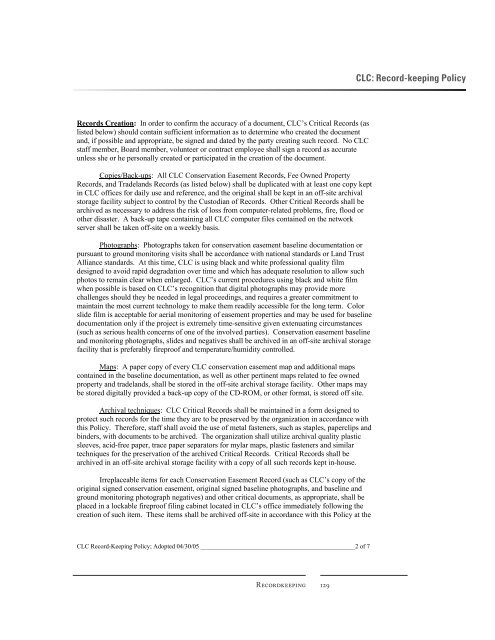Managing Conservation Easements in Perpetuity - Environmental ...
Managing Conservation Easements in Perpetuity - Environmental ...
Managing Conservation Easements in Perpetuity - Environmental ...
Create successful ePaper yourself
Turn your PDF publications into a flip-book with our unique Google optimized e-Paper software.
Records Creation: In order to confirm the accuracy of a document, CLC’s Critical Records (as<br />
listed below) should conta<strong>in</strong> sufficient <strong>in</strong>formation as to determ<strong>in</strong>e who created the document<br />
and, if possible and appropriate, be signed and dated by the party creat<strong>in</strong>g such record. No CLC<br />
staff member, Board member, volunteer or contract employee shall sign a record as accurate<br />
unless she or he personally created or participated <strong>in</strong> the creation of the document.<br />
Copies/Back-ups: All CLC <strong>Conservation</strong> Easement Records, Fee Owned Property<br />
Records, and Tradelands Records (as listed below) shall be duplicated with at least one copy kept<br />
<strong>in</strong> CLC offices for daily use and reference, and the orig<strong>in</strong>al shall be kept <strong>in</strong> an off-site archival<br />
storage facility subject to control by the Custodian of Records. Other Critical Records shall be<br />
archived as necessary to address the risk of loss from computer-related problems, fire, flood or<br />
other disaster. A back-up tape conta<strong>in</strong><strong>in</strong>g all CLC computer files conta<strong>in</strong>ed on the network<br />
server shall be taken off-site on a weekly basis.<br />
Photographs: Photographs taken for conservation easement basel<strong>in</strong>e documentation or<br />
pursuant to ground monitor<strong>in</strong>g visits shall be accordance with national standards or Land Trust<br />
Alliance standards. At this time, CLC is us<strong>in</strong>g black and white professional quality film<br />
designed to avoid rapid degradation over time and which has adequate resolution to allow such<br />
photos to rema<strong>in</strong> clear when enlarged. CLC’s current procedures us<strong>in</strong>g black and white film<br />
when possible is based on CLC’s recognition that digital photographs may provide more<br />
challenges should they be needed <strong>in</strong> legal proceed<strong>in</strong>gs, and requires a greater commitment to<br />
ma<strong>in</strong>ta<strong>in</strong> the most current technology to make them readily accessible for the long term. Color<br />
slide film is acceptable for aerial monitor<strong>in</strong>g of easement properties and may be used for basel<strong>in</strong>e<br />
documentation only if the project is extremely time-sensitive given extenuat<strong>in</strong>g circumstances<br />
(such as serious health concerns of one of the <strong>in</strong>volved parties). <strong>Conservation</strong> easement basel<strong>in</strong>e<br />
and monitor<strong>in</strong>g photographs, slides and negatives shall be archived <strong>in</strong> an off-site archival storage<br />
facility that is preferably fireproof and temperature/humidity controlled.<br />
Maps: A paper copy of every CLC conservation easement map and additional maps<br />
conta<strong>in</strong>ed <strong>in</strong> the basel<strong>in</strong>e documentation, as well as other pert<strong>in</strong>ent maps related to fee owned<br />
property and tradelands, shall be stored <strong>in</strong> the off-site archival storage facility. Other maps may<br />
be stored digitally provided a back-up copy of the CD-ROM, or other format, is stored off site.<br />
Archival techniques: CLC Critical Records shall be ma<strong>in</strong>ta<strong>in</strong>ed <strong>in</strong> a form designed to<br />
protect such records for the time they are to be preserved by the organization <strong>in</strong> accordance with<br />
this Policy. Therefore, staff shall avoid the use of metal fasteners, such as staples, paperclips and<br />
b<strong>in</strong>ders, with documents to be archived. The organization shall utilize archival quality plastic<br />
sleeves, acid-free paper, trace paper separators for mylar maps, plastic fasteners and similar<br />
techniques for the preservation of the archived Critical Records. Critical Records shall be<br />
archived <strong>in</strong> an off-site archival storage facility with a copy of all such records kept <strong>in</strong>-house.<br />
Irreplaceable items for each <strong>Conservation</strong> Easement Record (such as CLC’s copy of the<br />
orig<strong>in</strong>al signed conservation easement, orig<strong>in</strong>al signed basel<strong>in</strong>e photographs, and basel<strong>in</strong>e and<br />
ground monitor<strong>in</strong>g photograph negatives) and other critical documents, as appropriate, shall be<br />
placed <strong>in</strong> a lockable fireproof fil<strong>in</strong>g cab<strong>in</strong>et located <strong>in</strong> CLC’s office immediately follow<strong>in</strong>g the<br />
creation of such item. These items shall be archived off-site <strong>in</strong> accordance with this Policy at the<br />
CLC Record-Keep<strong>in</strong>g Policy; Adopted 04/30/05 _________________________________________________2 of 7<br />
Recordkeep<strong>in</strong>g 129<br />
CLC: Record-keep<strong>in</strong>g Policy


